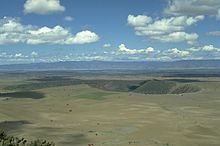비강도
Specific strength특정 강도는 물질의 강도(또는 근육의 강도)를 밀도로 나눈 값이다.강도 대 중량비 또는 강도 대 중량비 또는 강도 대 질량비라고도 합니다.섬유 또는 섬유 어플리케이션에서 끈기는 특정 강도의 일반적인 척도입니다.특정 강도의 SI 단위는 Pamm3/kg 또는 N nm/kg으로 m/s와2 치수적으로2 동등하지만 후자의 형태는 거의 사용되지 않는다.비강도는 비에너지와 동일한 단위를 가지며 원심력에 의해 물체가 흩어지지 않고 가질 수 있는 최대 회전 비에너지와 관련이 있다.
특정 강도를 설명하는 또 다른 방법은 파단 길이(자기 지지 길이라고도 함)입니다. 즉, 상단에서만 지지할 때 재료의 수직 기둥(고정 단면 가정)의 최대 길이입니다.이 측정에서 무게의 정의는 높이와 함께 감소하지 않고 재료의 전체 길이에 적용되는 지구 표면에서의 중력(표준 중력, 9.80665m/s2)이다.이 사용법은 특정 특수 섬유 또는 섬유 애플리케이션에서 더 일반적입니다.
특정 강도가 가장 높은 재료는 일반적으로 탄소 섬유, 유리 섬유 및 다양한 폴리머와 같은 섬유이며 복합 재료(예: 탄소 섬유 에폭시)를 만드는 데 자주 사용됩니다.이러한 재료와 티타늄, 알루미늄, 마그네슘 및 고강도 강철 합금과 같은 기타 재료는 무게를 줄일 가치가 있는 항공우주 및 기타 용도로 널리 사용됩니다.
강도와 강성은 구별된다는 점에 유의하십시오.둘 다 효율적이고 안전한 구조물의 설계에 중요하다.
파단 길이 계산
서L(\ L은 길이, 는 인장강도,(\는 밀도,g(\{는 중력에 의한 가속도입니다 9 99.
예
| 재료. | 인장 강도 (MPa) | 밀도 (cm/g3) | 비강도 (kN·m/kg) | 파단 길이 (km) | 원천 |
|---|---|---|---|---|---|
| 구체적인 | 2–5 | 2.30 | 5.22 | 0.44 | |
| 폴리옥시메틸렌, POM | 69 | 1.42 | 4.95 | [1] | |
| 고무 | 15 | 0.92 | 16.3 | 1.66 | |
| 구리 | 220 | 8.92 | 24.7 | 2.51 | |
| 폴리프로필렌, PP | 25–40 | 0.90 | 28–44 | 2.8–4.5 | [2] |
| 폴리 아크릴로니트릴부타디엔스티렌(ABS) | 41–45 | 1.05 | 39–43 | [3] | |
| 폴리에틸렌 테레프탈레이트, 폴리에스테르, PET | 80 | 1.3–1.4 | 57–62 | [4] | |
| 피아노 와이어, ASTM 228 스틸 | 1590–3340 | 7.8 | 204–428 | [5] | |
| 폴리유산, 폴리락티드, PLA | 53 | 1.24 | 43 | [6] | |
| 저탄소강(AISI 1010) | 365 | 7.87 | 46.4 | 4.73 | [7] |
| 스테인리스강(304) | 505 | 8.00 | 63.1 | 6.4 | [8] |
| 마징강(C350) | 2358 | 8.08 | 291.74 | 29.7 | [9] |
| 금관 악기 | 580 | 8.55 | 67.8 | 6.91 | [10] |
| 나일론 | 78 | 1.13 | 69.0 | 7.04 | [11] |
| 티타늄 | 344 | 4.51 | 76 | 7.75 | [12] |
| CrMo 스틸 (4130) | 560–670 | 7.85 | 71–85 | 7.27–8.70 | [13][14] |
| 알루미늄 합금(6061-T6) | 310 | 2.70 | 115 | 11.70 | [15] |
| 오크 | 90 | 0.78–0.69 | 115–130 | 12–13 | [16] |
| 인코넬(X-750) | 1250 | 8.28 | 151 | 15.4 | [17] |
| 마그네슘 합금 | 275 | 1.74 | 158 | 16.1 | [18] |
| 알루미늄 합금(7075-T6) | 572 | 2.81 | 204 | 20.8 | [19] |
| 소나무(미국 동부 흰색) | 78 | 0.35 | 223 | 22.7 | [20] |
| 티타늄 합금(베타 C) | 1250 | 4.81 | 260 | 26.5 | [21] |
| 베이나이트 | 2500 | 7.87 | 321 | 32.4 | [22] |
| 발사 | 73 | 0.14 | 521 | 53.2 | [23] |
| 탄소-에폭시 복합체 | 1240 | 1.58 | 785 | 80.0 | [24] |
| 거미줄 | 1400 | 1.31 | 1069 | 109 | |
| 탄화규소섬유 | 3440 | 3.16 | 1088 | 110 | [25] |
| 미랄론 카본 나노튜브 실 C계 | 1375 | 0.7–0.9 | 1100 | 112 | [26] |
| 유리 섬유 | 3400 | 2.60 | 1307 | 133 | [27] |
| 현무암 섬유 | 4840 | 2.70 | 1790 | 183 | [28] |
| 1μm 철제 수염 | 14000 | 7.87 | 1800 | 183 | [22] |
| 벡트란 | 2900 | 1.40 | 2071 | 211 | [27] |
| 탄소섬유(AS4) | 4300 | 1.75 | 2457 | 250 | [27] |
| 케블라 | 3620 | 1.44 | 2514 | 256 | [29] |
| 다이나마(UHMWPE) | 3600 | 0.97 | 3711 | 378 | [30] |
| 자일론 | 5800 | 1.54 | 3766 | 384 | [31] |
| 탄소섬유(Toray T1100G) | 7000 | 1.79 | 3911 | 399 | [32] |
| 카본나노튜브(아래 주 참조) | 62000 | 0.037–1.34 | 46268 – 없음 | 4716 – 없음 | [33][34] |
| 거대 탄소 튜브 | 6900 | 0.116 | 59483 | 6066 | [35] |
| 그래핀 | 130500 | 2.090 | 62453 | 6366 | [36] |
| 기본 한계 | 9×1013 | 9.2×1012 | [37] |
이 표의 데이터는 베스트 케이스에서 얻은 것으로 대략적인 수치를 나타내기 위해 작성되었습니다.
주의: 다벽 카본 나노튜브는 지금까지 측정된 재료 중 가장 높은 인장 강도를 가지고 있으며, 연구소에서 인장 강도 63GPa로 여전히 이론 한계인 300GPa를 [33]훨씬 밑돌고 있습니다.(2000년에) 인장 강도가 발표된 최초의 나노튜브 로프(20mm 길이)의 강도는 3.6 GPa로, 여전히 이론적 [38]한계를 훨씬 밑돌았다.밀도는 제조 방법에 따라 다르며, 최저값은 0.037 또는 0.55(고체)[34]입니다.
'유리'와 우주 테더
국제우주엘리베이터컨소시엄은 특정 강도를 나타내는 SI 단위의 이름으로 "유리"를 사용한다.특정 강도는 우주 엘리베이터 케이블 재료의 설명에서 기본적으로 중요합니다.1개의 유리는 장력을 받는 물질의 밀도 단위당 항복 응력(또는 파괴 응력)에 대한 SI 단위로 간주됩니다.1개의 유리는 1Pa3/m/kg 또는 1N/m/kg입니다.이것은 장력 [39][40]하에서의 케이블의 선형 밀도당 파괴력/항복력입니다.지구 우주 엘리베이터가 작동하려면 30~80메가미터의 테더가 필요합니다.유리(파단 [41]길이 3100–8200km에 해당).
비강도에 대한 기본 한계
null 에너지 조건은 모든 [37]물질의 특정 강도에 근본적인 한계를 둡니다.특정 강도는 c ~9×1013 kNµm/kg 이하이며2, 여기서 c는 빛의 속도이다.이 한계는 전기 및 자기장 라인, QCD 플럭스 튜브 및 스트링 [citation needed]이론에 의해 가정된 기본 스트링에 의해 달성됩니다.
끈기(직물 강도)
끈기는 섬유나 실의 강도를 측정하는 관례적인 척도입니다.보통 파이버의 최종(파단)힘(그램힘 단위)을 데니어(denier)로 나눈 값으로 정의됩니다.데니어는 선형 밀도의 측정값이기 때문에 끈기는 단위 면적당 힘의 측정값이 아니라 특정 [42]강도와 유사한 준차원 측정값으로 판명됩니다.1{1\displaystyle}의 불굴에:[표창 필요한]1g⋅ 9.80665 ms− 2대 1g/9000m)9.80665 m여서 − 21/9000m)9.80665 m여서 − 29000m)88259.85 m2s− 2{\displaystyle{\frac{1{\rm{\,g}}\cdot 9.80665{\rm{\,ms^{-2}}}}{1{\rm 해당합니다. {\,g}}/9000{\rmms{,{,m}={,대부분 ctex에서 나타내는 강도 보고서입니다.
「 」를 참조해 주세요.
레퍼런스
- ^ "Acetal Polyoxymethylene Homopolymer - POM". AZoM.com. August 30, 2001. Archived from the original on July 22, 2020. Retrieved July 22, 2020.
- ^ "Polypropylene - online catalogue source - supplier of research materials in small quantities - Goodfellow". www.goodfellow.com. Archived from the original on 2018-08-07. Retrieved 2017-04-24.
- ^ "Polyacrylonitrile-butadiene-styrene - online catalogue source - supplier of research materials in small quantities - Goodfellow". www.goodfellow.com. Archived from the original on 2018-12-20. Retrieved 2018-07-29.
- ^ "Polyethylene terephthalate - online catalogue source - supplier of research materials in small quantities - Goodfellow". www.goodfellow.com. Archived from the original on 2019-04-17. Retrieved 2018-07-29.
- ^ "ASTM A228 Steel (UNS K08500)". www.matweb.com. Archived from the original on 2019-01-19. Retrieved 2019-01-17.
- ^ "Polylactic acid - Biopolymer - online catalogue source - supplier of research materials in small quantities - Goodfellow". www.goodfellow.com. Archived from the original on 2018-07-29. Retrieved 2018-07-29.
- ^ "AISI 1010 Steel, cold drawn". matweb.com. Archived from the original on 2018-04-18. Retrieved 2015-10-20.
- ^ "ASM Material Data Sheet". asm.matweb.com. Archived from the original on 2018-10-01. Retrieved 2015-10-20.
- ^ "SSA Corp Maraging Data Sheet" (PDF). www.ssa-corp.com. Archived (PDF) from the original on 2021-06-29. Retrieved 2021-06-29.
- ^ "Properties of Copper Alloys". roymech.co.uk. Archived from the original on 2019-03-30. Retrieved 2006-04-17.
- ^ "Polyamide - Nylon 6 - online catalogue source - supplier of research materials in small quantities - Goodfellow". www.goodfellow.com. Archived from the original on 2019-04-17. Retrieved 2017-04-24.
- ^ "ASM Material Data Sheet". asm.matweb.com. Archived from the original on 2019-03-22. Retrieved 2016-11-14.
- ^ "ASM Material Data Sheet". asm.matweb.com. Archived from the original on 2019-04-06. Retrieved 2016-08-18.
- ^ "ASM Material Data Sheet". asm.matweb.com. Archived from the original on 2012-03-15. Retrieved 2016-08-18.
- ^ "ASM Material Data Sheet". asm.matweb.com. Archived from the original on 2018-10-22. Retrieved 2016-08-18.
- ^ "Environmental data: Oak wood". Archived from the original on 9 October 2007. Retrieved 2006-04-17.
{{cite web}}: CS1 maint: bot: 원래 URL 상태를 알 수 없습니다(링크). - ^ "ASM Material Data Sheet". asm.matweb.com. Archived from the original on 2018-10-04. Retrieved 2015-10-20.
- ^ "eFunda: Typical Properties of Magnesium Alloys". www.efunda.com. Archived from the original on 2020-01-30. Retrieved 2021-10-01.
- ^ "ASM Material Data Sheet". asm.matweb.com. Archived from the original on 2018-10-16. Retrieved 2015-10-20.
- ^ "American Eastern White Pine Wood". www.matweb.com. Archived from the original on 2019-12-08. Retrieved 2019-12-08.
- ^ "AZo Materials Data Sheet". azom.com. 11 February 2003. Archived from the original on 2017-06-23. Retrieved 2016-11-14.
- ^ a b 제52회 햇필드 기념 강연: H. K. D. H. Bhadeshia 2005의 "매우 강한 강철의 큰 덩어리" archive.is
- ^ "MatWeb – The Online Materials Information Resource". matweb.com. Archived from the original on 2015-04-02. Retrieved 2009-06-29.
- ^ McGRAW-HILL 과학기술 백과사전 제8판, (c) 1997, 제1권 375호
- ^ "Specialty Materials, Inc SCS Silicon Carbide Fibers". Archived from the original on 2018-04-04. Retrieved 2006-04-17.
- ^ NanoComp Technologies Inc. "Miralon Yarn" (PDF). Archived (PDF) from the original on 2018-12-20. Retrieved 2018-12-19.
- ^ a b c "Vectran". Vectran Fiber, Inc. Archived from the original on 2019-07-08. Retrieved 2017-06-12.
- ^ "RWcarbon.com – The Source for BMW & Mercedes Carbon Fiber Aero Parts". rwcarbon.com. Archived from the original on 2019-05-03. Retrieved 2021-10-01.
- ^ "Network Group for Composites in Construction: Introduction to Fibre Reinforced Polymer Composites". Archived from the original on January 18, 2006. Retrieved 2006-04-17.
{{cite web}}: CS1 maint: bot: 원래 URL 상태를 알 수 없습니다(링크). - ^ "Dyneema Fact sheet". DSM. 1 January 2008. Archived from the original on 8 August 2019. Retrieved 23 May 2016.
- ^ Toyobo Co., Ltd. "ザイロン®(PBO 繊維)技術資料 (2005)" (PDF). Archived from the original (free download PDF) on 2012-04-26.
- ^ Toray Composites Materials America, Co., Ltd. "T1100S, INTERMEDIATE MODULUS CARBON FIBER" (free download PDF). Archived (PDF) from the original on 2021-07-13. Retrieved 2021-06-29.
{{cite web}}: CS1 maint: 여러 이름: 작성자 목록(링크) - ^ a b Yu, Min-Feng; Lourie, Oleg; Dyer, Mark J.; Moloni, Katerina; Kelly, Thomas F.; Ruoff, Rodney S. (28 January 2000). "Strength and Breaking Mechanism of Multiwalled Carbon Nanotubes Under Tensile Load" (PDF). Science. 287 (5453): 637–640. Bibcode:2000Sci...287..637Y. doi:10.1126/science.287.5453.637. PMID 10649994. Archived from the original (PDF) on 4 March 2011.
- ^ a b K.Hata (2007). "From highly efficient impurity-free CNT synthesis to DWNT forests, CNT solids, and super-capacitors" (PDF). In Razeghi, Manijeh; Brown, Gail J (eds.). From Highly Efficient Impurity-Free CNT Synthesis to DWNT forests, CNTsolids and Super-Capacitors. Quantum Sensing and Nanophotonic Devices IV. Vol. 6479. pp. 64791L. doi:10.1117/12.716279. S2CID 136421231. Archived (PDF) from the original on 2018-12-15. Retrieved 2009-12-02.
- ^ Peng, H.; Chen, D.; et al., Huang J.Y.; et al. (2008). "Strong and Ductile Colossal Carbon Tubes with Walls of Rectangular Macropores". Phys. Rev. Lett. 101 (14): 145501. Bibcode:2008PhRvL.101n5501P. doi:10.1103/PhysRevLett.101.145501. PMID 18851539.
- ^ "2010 Nobel Physics Laureates" (PDF). nobelprize.org. Archived (PDF) from the original on 2018-07-01. Retrieved 2019-03-28.
- ^ a b Brown, Adam R. (2013). "Tensile Strength and the Mining of Black Holes". Physical Review Letters. 111 (21): 211301. arXiv:1207.3342. Bibcode:2013PhRvL.111u1301B. doi:10.1103/PhysRevLett.111.211301. PMID 24313473. S2CID 16394667.
- ^ Li, F.; Cheng, H. M.; Bai, S.; Su, G.; Dresselhaus, M. S. (2000). "Tensile strength of single-walled carbon nanotubes directly measured from their macroscopic ropes". Applied Physics Letters. 77 (20): 3161–3163. Bibcode:2000ApPhL..77.3161L. doi:10.1063/1.1324984.
- ^ "Strong Tether Challenge 2013" (PDF). Archived from the original (PDF) on 2016-01-14.
- ^ "Terminology". isec.org. Archived from the original on 2012-05-27.
- ^ "Specific Strength in Yuris". keithcu.com. Archived from the original on 2019-02-09. Retrieved 2012-06-02.
- ^ Rodriguez, Ferdinand (1989). Principles of Polymer Systems (3rd ed.). New York: Hemisphere Publishing. p. 282. ISBN 9780891161769. OCLC 19122722.

 길이,
길이,  인장강도,
인장강도, 밀도,
밀도,
 중력에 의한 가속도입니다
중력에 의한 가속도입니다



